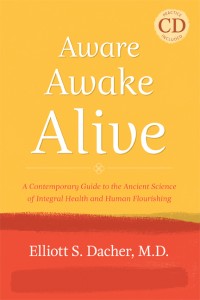 The notion that a typical mature, well-adjusted person in our culture is alienated from or out of touch with their bodies may seem, at first blush, curious if not absurd. Most of us yelp out in pain when we stub our toes, enjoy the pleasure of making love, notice when we’re hungry, and are saddened by tragedy. Obviously, to say that one is relatively disembodied does not mean one is an anesthetized “floating head” bumping into things all the time. The issue is far more subtle and compelling, having to do with the quality of our relationships to self, others, and environment, and how our experience of those relationships is shaped by the processes of development and socialization. Disembodiment simply refers to a diminished capacity to be sensually aware and the subsequent inability to respond to life’s continual challenges from the fullness of such a sensually grounded awareness.
The notion that a typical mature, well-adjusted person in our culture is alienated from or out of touch with their bodies may seem, at first blush, curious if not absurd. Most of us yelp out in pain when we stub our toes, enjoy the pleasure of making love, notice when we’re hungry, and are saddened by tragedy. Obviously, to say that one is relatively disembodied does not mean one is an anesthetized “floating head” bumping into things all the time. The issue is far more subtle and compelling, having to do with the quality of our relationships to self, others, and environment, and how our experience of those relationships is shaped by the processes of development and socialization. Disembodiment simply refers to a diminished capacity to be sensually aware and the subsequent inability to respond to life’s continual challenges from the fullness of such a sensually grounded awareness.
That human beings become increasing able to think as they mature into adulthood obviously endows the developing person with greater potential and possibility in life. Contrary to the popularized personal growth motto of “lose your mind and come back to your senses,” any holistic inquiry into personal health and healing realizes the value of cognitive development. But there is a difference between adding a layer of depth in human awareness (moving from a vibrant, feeling-centered being to a being who also has a well developed capacity to think — a “bodymind” if you will), and losing touch with basic levels of awareness (becoming a thinking-centered being who has lost much of their capacity to express themselves from a sensually-grounded awareness). The latter is a pathological state of affairs that, unfortunately, is built in to the very fabric of modern society, shaping the lives of individuals in ways that distort and deny the fullness of experience.
Phenomenologist Elizabeth Behnke calls the tendency to distance ourselves from our own bodily lives the “I-it structure of experience,” which often manifests in our culture as the unshakable sense that our perceiving selves are situated somewhere “in our heads.” From this I-it perspective, my legs are perceived as “down there” as opposed to me being “up here.” When I feel pain in my back or head I say that “it” hurts. My sense is that I have experiences or that experiences happen to me. An emotion, for instance, might be perceived as if it were some “thing” that was temporarily affecting me in some way.
This mode of bodily experiencing, undoubtedly the norm for most of us most of the time, has to do with our sense of identity or who we take ourselves to be. While bodily impulses and feelings may be perceived, they are experienced as outside of one’s essential identity. Philosopher Ken Wilber (in his book No Boundary) has described this way of experiencing as one in which an artificial boundary is perceived in regard to one’s total organism, such that the entire bodily-felt realm is projected outward as not-self. Thus, a typical Westerner is likely to claim that they are their mind while they simply have a body. In the mature, well-adjusted, normal adult, this bodymind fragmentation doesn’t mean that one would fail to notice being on fire. It does mean, however, that one operates from a “locus of identity” that is situated on the ego side of an ego-flesh perceptual boundary. An individual centered on the mind or egoic side of this boundary may be aware of bodily experience, but only as an object of awareness. As psychologist R.D. Laing (in his book The Divided Self) describes this “unembodied” self: “The body is felt more as one object among other objects in the world than as the core of the individual’s own being.” In this subtle yet telling way, mind and body are dissociated in awareness, and perception of self and world is thereby distorted to fit that dissociation.
It is fairly clear that this level of bodymind dissociation is considered normal and healthy in our culture. Many of us certainly live as if we were essentially minds at the helm of our bodies—keeping them healthy and satisfied for as long as we find ourselves in them. When we experience back pain, the typical response is to go to a specialist to get it fixed or adjusted, just as we do our cars. Anxiety, especially when not consciously linked to obvious circumstances, is often treated as a “thing,” a symptom to be vanquished by medication or positive thinking.
The difference between the dissociated and embodied modes of experience may sound trivial in the abstract, but we’ve all experienced the contrast keenly in our daily lives. It is the difference between merely recognizing you are sad, and feeling that sadness in the full release of crying. It is the difference between merely believing you love someone, and actually being in love with that person, feeling the intensity of connection in the moment. Anyone who’s ever “lost themselves” in a sunset, or in a musical jam-session, or in the tender embrace of a loved one, can recognize this shift toward full-bodied perception. Actually, one’s “self” is not at all lost in this manner of experiencing. What’s lost is only one’s tendency to keep their attention confined to the thought-centered processes of the total psychophysical organism.
In contemporary society, our capacity to deeply enter into the sensual flow of experience is typically utilized less and less as we adapt to an increasingly mind-centered lifestyle, and it becomes atrophied and left poorly developed. This relative disembodiment places unnecessary limits on people’s personal health and growth. Thus, a person may recognize that they’re sad, anxious, or depressed, perceiving these feeling states well enough to talk about them in quite sophisticated ways, yet nonetheless remain stuck in the same familiar patterns. Consciously unable (and unconsciously unwilling) to engage personal issues in their sensual fullness, we necessarily struggle to get through and beyond the inner conflicts and issues that hold us back in life.
The I-it mode of experiencing is certainly not, in-and-of-itself, a bad thing. Problems can and do arise, however, when an I-it mode of perceiving and responding becomes so habituated that, without realizing it, human beings gradually lose their capacity to experience life in any other way. Instead of a mode of perceiving and responding consciously utilized in an appropriate situation, I-it objectivity becomes the unconscious way one approaches nearly all situations. As we shall see, the dis-identification with our sensual existence that characterizes the I-it mode of being, when operating in a habitual and unconscious fashion, can keep people stuck in unhealthy and unfulfilling ruts, distorting people’s experience in ways that interfere with the process of personal transformation. When you approach the world with only a hammer, so to speak, everything starts to look like a nail. And if this illusion becomes too convincing, things start to get all bent out of shape.
 I’m still savoring Elliot Dacher‘s excellent new book, Aware, Awake, Alive. Obviously, I’m interested in the whole notion of Integral Health in general, and Dacher has perhaps done more than anyone to articulate just what an integral vision of health means, distinguishing an integral approach from both conventional medicine and complimentary/alternative (CAM) approaches. Here’s how Dacher puts it in Aware Awake Alive:
I’m still savoring Elliot Dacher‘s excellent new book, Aware, Awake, Alive. Obviously, I’m interested in the whole notion of Integral Health in general, and Dacher has perhaps done more than anyone to articulate just what an integral vision of health means, distinguishing an integral approach from both conventional medicine and complimentary/alternative (CAM) approaches. Here’s how Dacher puts it in Aware Awake Alive:

 The notion that a typical mature, well-adjusted person in our culture is alienated from or out of touch with their bodies may seem, at first blush, curious if not absurd. Most of us yelp out in pain when we stub our toes, enjoy the pleasure of making love, notice when we’re hungry, and are saddened by tragedy. Obviously, to say that one is relatively disembodied does not mean one is an anesthetized “floating head” bumping into things all the time. The issue is far more subtle and compelling, having to do with the quality of our relationships to self, others, and environment, and how our experience of those relationships is shaped by the processes of development and socialization. Disembodiment simply refers to a diminished capacity to be sensually aware and the subsequent inability to respond to life’s continual challenges from the fullness of such a sensually grounded awareness.
The notion that a typical mature, well-adjusted person in our culture is alienated from or out of touch with their bodies may seem, at first blush, curious if not absurd. Most of us yelp out in pain when we stub our toes, enjoy the pleasure of making love, notice when we’re hungry, and are saddened by tragedy. Obviously, to say that one is relatively disembodied does not mean one is an anesthetized “floating head” bumping into things all the time. The issue is far more subtle and compelling, having to do with the quality of our relationships to self, others, and environment, and how our experience of those relationships is shaped by the processes of development and socialization. Disembodiment simply refers to a diminished capacity to be sensually aware and the subsequent inability to respond to life’s continual challenges from the fullness of such a sensually grounded awareness.


